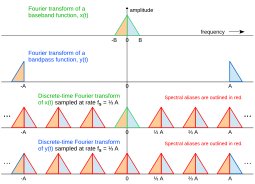
Back Submostreig (processament del senyal) Catalan Unterabtastung German Aladiskreetimine Estonian 언더샘플링 Korean Pensampelan bawah Malay Onderbemonstering Dutch Subeșantionare Romanian


In signal processing, undersampling or bandpass sampling is a technique where one samples a bandpass-filtered signal at a sample rate below its Nyquist rate (twice the upper cutoff frequency), but is still able to reconstruct the signal.
When one undersamples a bandpass signal, the samples are indistinguishable from the samples of a low-frequency alias of the high-frequency signal. Such sampling is also known as bandpass sampling, harmonic sampling, IF sampling, and direct IF-to-digital conversion.[1]
- ^ Walt Kester (2003). Mixed-signal and DSP design techniques. Newnes. p. 20. ISBN 978-0-7506-7611-3.